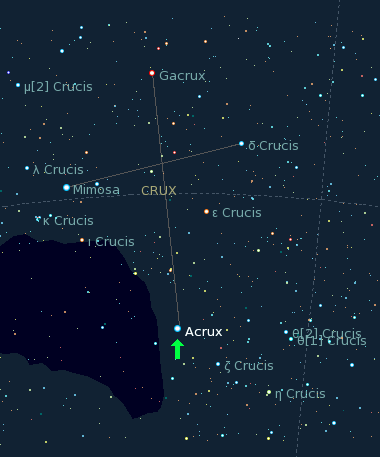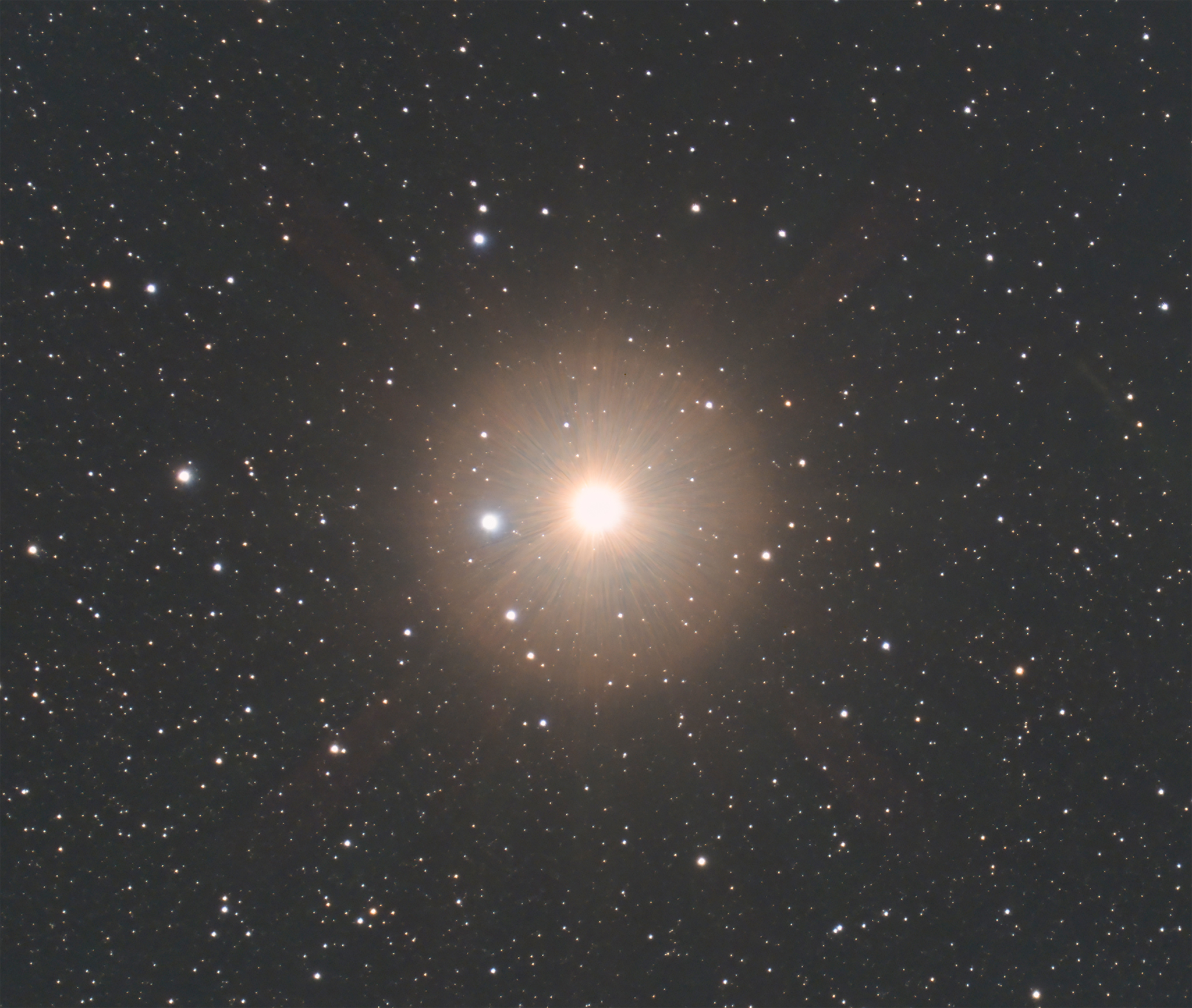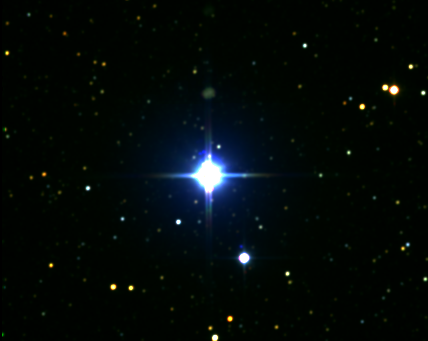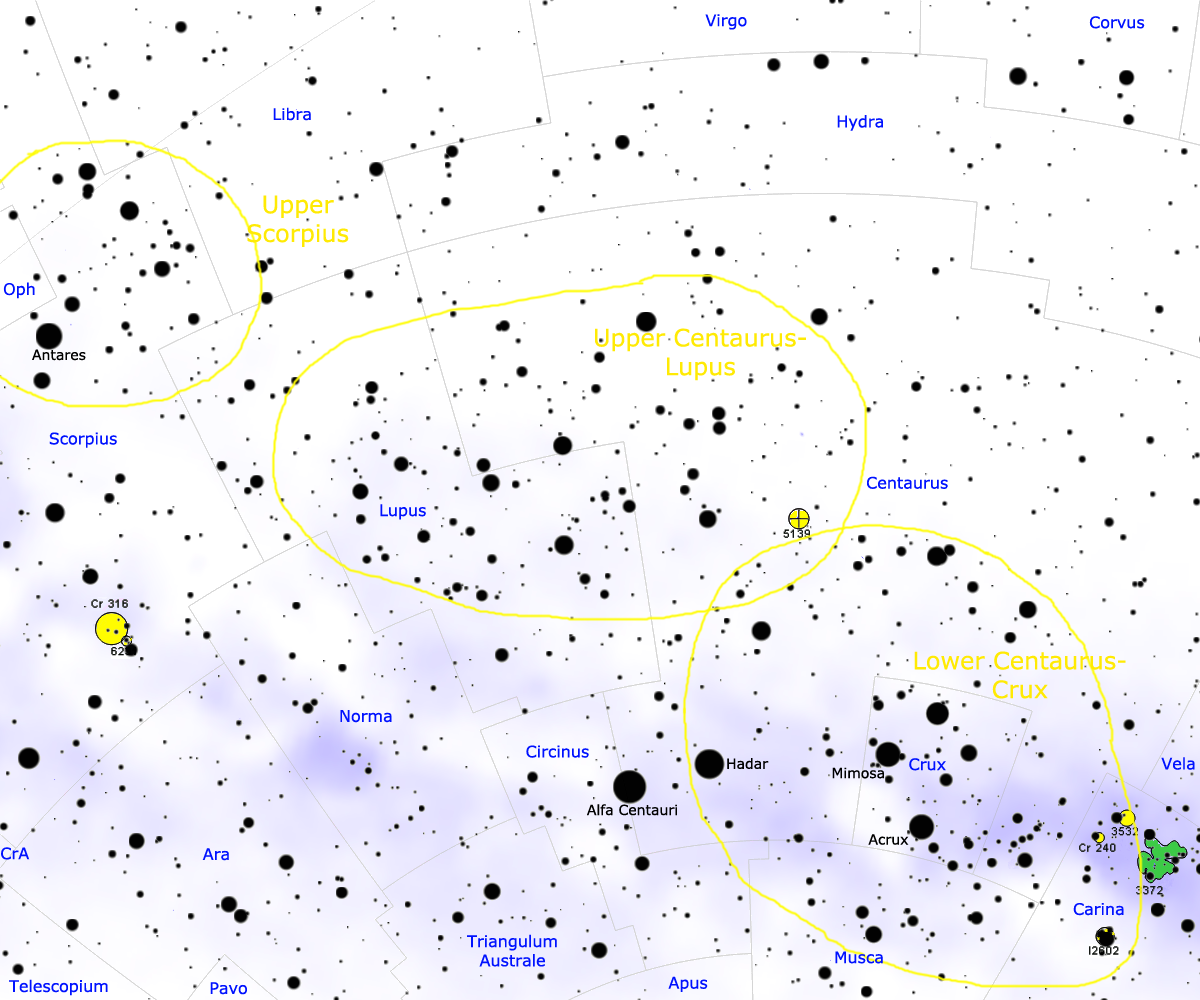|
Crux
Crux () is a constellation of the southern sky that is centred on four bright stars in a cross-shaped asterism commonly known as the Southern Cross. It lies on the southern end of the Milky Way's visible band. The name ''Crux'' is Latin for cross. Even though it is the smallest of all 88 modern constellations, Crux is among the most easily distinguished as its four main stars each have an apparent visual magnitude brighter than +2.8. It has attained a high level of cultural significance in many Southern Hemisphere states and nations. Blue-white α Crucis (Acrux) is the most southerly member of the constellation and, at magnitude 0.8, the brightest. The three other stars of the cross appear clockwise and in order of lessening magnitude: β Crucis (Mimosa), γ Crucis (Gacrux), and δ Crucis (Imai). ε Crucis (Ginan) also lies within the cross asterism. Many of these brighter stars are members of the Scorpius–Centaurus association, a large but loose group of hot blue-whit ... [...More Info...] [...Related Items...] OR: [Wikipedia] [Google] [Baidu] |
β Crucis
Mimosa is the second-brightest object in the southern constellation of Crux (after Acrux), and the 20th-brightest star in the night sky. It has the Bayer designation β Crucis, which is Latinised to Beta Crucis and abbreviated Beta Cru or β Cru. Mimosa forms part of the prominent asterism called the Southern Cross. It is a binary star or a possible triple star system. Nomenclature ''β Crucis'' (Latinised to ''Beta Crucis'') is the system's Bayer designation. Although Mimosa is at roughly −60° declination, and therefore not visible north of 30° latitude, in the time of the ancient Greeks and Romans it was visible north of 40° due to the precession of equinoxes, and these civilizations regarded it as part of the constellation of Centaurus. It bore the traditional names ''Mimosa'' and the historical name ''Becrux'' . ''Mimosa'', which is derived from the Latin for 'actor', may come from the flower of the same name. ''Becrux'' is a modern contraction o ... [...More Info...] [...Related Items...] OR: [Wikipedia] [Google] [Baidu] |
α Crucis
Acrux is the brightest star in the southern constellation of Crux. It has the Bayer designation α Crucis, which is Latinised to Alpha Crucis and abbreviated Alpha Cru or α Cru. With a combined visual magnitude of +0.76, it is the 13th-brightest star in the night sky. It is the most southerly star of the asterism known as the Southern Cross and is the southernmost first-magnitude star, 2.3 degrees more southerly than Alpha Centauri. This system is located at a distance of 321 light-years from the Sun. To the naked eye Acrux appears as a single star, but it is actually a multiple star system containing six components. Through optical telescopes, Acrux appears as a triple star, whose two brightest components are visually separated by about 4 arcseconds and are known as Acrux A and Acrux B, α1 Crucis and α2 Crucis, or α Crucis A and α Crucis B. Both components are B-type stars, and are many times more massive and luminous than the Sun. α1 Crucis is itself a spect ... [...More Info...] [...Related Items...] OR: [Wikipedia] [Google] [Baidu] |
γ Crucis
Gacrux it is the third-brightest star in the southern constellation of Crux, the Southern Cross. It has the Bayer designation Gamma Crucis, which is Latinised from γ Crucis and abbreviated Gamma Cru or γ Cru. With an apparent visual magnitude of +1.63, it is the 26th brightest star in the night sky. A line from the two "Pointers", Alpha Centauri through Beta Centauri, leads to within 1° north of this star. Using parallax measurements made during the Hipparcos mission, it is located at a distance of from the Sun. It is the nearest red giant star to the Sun. Nomenclature ''γ Crucis'' (Latinised to ''Gamma Crucis'') is the star's Bayer designation. Since Gacrux is at roughly −60° declination. It was known to the ancient Greeks and Romans, but oddly in the era lacked a traditional name, and was visible north of 40° latitude due to the precession of equinoxes. The astronomer Ptolemy counted it as part of the constellation of Centaurus. The historical name ''Gacru ... [...More Info...] [...Related Items...] OR: [Wikipedia] [Google] [Baidu] |
δ Crucis
Delta Crucis or δ Crucis, also identified as Imai (), is a star in the southern constellation of Crux, and is the faintest of the four bright stars that form the prominent asterism known as the Southern Cross. This star has an apparent magnitude of 2.8, and its proper name was adopted by the International Astronomical Union on 10 August 2018. Imai is a massive, hot and rapidly rotating star that is in the process of evolving into a giant, and is located at a distance of about from the Sun. Nomenclature ''δ Crucis'' ( Latinised to ''Delta Crucis'') is the star's Bayer designation. The International Astronomical Union Working Group on Star Names (WGSN) approved the name ''Imai'' for this star on 10 August 2018 and it is in the list of IAU-approved star names. ''Imai'' is the name selected for the star designated Delta Crucis by the Mursi people of modern-day Ethiopia. The star Imai has some significance as when it "ceases to appear in the evening sky at dusk (around t ... [...More Info...] [...Related Items...] OR: [Wikipedia] [Google] [Baidu] |
ε Crucis
Epsilon Crucis, ε Crucis (abbreviated Eps Cru, ε Cru), also known as Ginan , is a single, orange-hued star in the southern constellation of Crux. Measurements made by the Hipparcos spacecraft showed an annual parallax shift of 14.19 mas, which provides a distance estimate of about 230 light years. The star can be seen with the naked eye, having an apparent visual magnitude of 3.58. It is moving closer to the Sun with a radial velocity of −4.60 km.s−1. This is a giant star of type K with a stellar classification of K3III, indicating that it has exhausted the hydrogen at its core and evolved away from the main sequence. It is about two billion years old with 1.5 times the mass of the Sun and has expanded to 28 times the Sun's radius. The star is shining with around 302 times the Sun's luminosity from its enlarged photosphere at an effective temperature of 4,294 K. Nomenclature ε Crucis ( Latinised to ''Epsilon Crucis'') is the star ... [...More Info...] [...Related Items...] OR: [Wikipedia] [Google] [Baidu] |
Alpha Crucis
Acrux is the brightest star in the southern constellation of Crux. It has the Bayer designation α Crucis, which is Latinised to Alpha Crucis and abbreviated Alpha Cru or α Cru. With a combined visual magnitude of +0.76, it is the 13th-brightest star in the night sky. It is the most southerly star of the asterism known as the Southern Cross and is the southernmost first-magnitude star, 2.3 degrees more southerly than Alpha Centauri. This system is located at a distance of 321 light-years from the Sun. To the naked eye Acrux appears as a single star, but it is actually a multiple star system containing six components. Through optical telescopes, Acrux appears as a triple star, whose two brightest components are visually separated by about 4 arcseconds and are known as Acrux A and Acrux B, α1 Crucis and α2 Crucis, or α Crucis A and α Crucis B. Both components are B-type stars, and are many times more massive and luminous than the Sun. α1 Crucis is itself a spe ... [...More Info...] [...Related Items...] OR: [Wikipedia] [Google] [Baidu] |
Musca
Musca () is a small constellation in the deep southern sky. It was one of 12 constellations created by Petrus Plancius from the observations of Pieter Dirkszoon Keyser and Frederick de Houtman, and it first appeared on a celestial globe in diameter published in 1597 (or 1598) in Amsterdam by Plancius and Jodocus Hondius. The first depiction of this constellation in a celestial atlas was in Johann Bayer's ''Uranometria'' of 1603. It was also known as Apis () for 200 years. Musca remains below the horizon for most Northern Hemisphere observers. Many of the constellation's brighter stars are members of the Scorpius–Centaurus association, a loose group of hot blue-white stars that appears to share a common origin and motion across the Milky Way. These include Alpha, Beta, Gamma, Zeta2 and (probably) Eta Muscae, as well as HD 100546, a blue-white Herbig Ae/Be star that is surrounded by a complex debris disk containing a large planet or brown dwarf and possible protoplanet. Two ... [...More Info...] [...Related Items...] OR: [Wikipedia] [Google] [Baidu] |
Coalsack Nebula
The Coalsack Nebula (Southern Coalsack, or simply the Coalsack) is a prominent dark nebula in the skies, being easily visible to the naked eye as a dark patch obscuring a brief section of Milky Way stars as they cross their southernmost region of the sky, east of Acrux (Alpha Crucis) which is the bright, southern pointer star of the southern cross. It dominates and overspills the southeast corner of what is considered the extent of the constellation Crux at a little less than twice the distance of Acrux, away from Earth. General information The Coalsack Nebula covers nearly 7 ° by 5° and overlaps somewhat with the neighbor constellations Centaurus and Musca. The first observation was reported by Vicente Yáñez Pinzón in 1499. It was named "''il Canopo fosco''" (the dark Canopus) by Amerigo Vespucci and was also called "''Macula Magellani''" (Magellan's Spot) or "''Black Magellanic Cloud''" in opposition to the Magellanic Clouds. The Coalsack is omitted in most of today's sta ... [...More Info...] [...Related Items...] OR: [Wikipedia] [Google] [Baidu] |
Eta Crucis
Eta Crucis (η Crucis) is a solitary star in the southern constellation of Crux. It can be seen with the naked eye, having an apparent visual magnitude of 4.14m. Based upon parallax measurements, η Crucis is located 64 light-years from the Sun. The system made its closest approach about 1.6 million years ago when it achieved perihelion at a distance of roughly 26 light years. This is an F-type main sequence star with a stellar classification of F2 V. It has 130% of the Sun's radius and shines with 7 times the luminosity of the Sun from an outer atmosphere with an effective temperature of 6,964 K. Observations of the system using the Spitzer Space Telescope show a statistically significant infrared excess of emission at a wavelength of 70 μm. This suggests the presence of a circumstellar disk. The temperature of this material is below 70 K. Eta Crucis has a pair of visual companions. Component B is a magnitude 11.80 star located at an an ... [...More Info...] [...Related Items...] OR: [Wikipedia] [Google] [Baidu] |
Jewel Box (star Cluster)
The Jewel Box (also known as the Kappa Crucis Cluster, NGC 4755, or Caldwell 94) is an open cluster in the constellation Crux, originally discovered by Nicolas Louis de Lacaille in 1751–1752. This cluster was later named the Jewel Box by John Herschel when he described its telescopic appearance as "...a superb piece of fancy jewellery". It is easily visible to the naked eye as a hazy star some 1.0° southeast of the first-magnitude star Mimosa (Beta Crucis). This hazy star was given the Bayer star designation "Kappa Crucis", from which the cluster takes one of its common names. The modern designation Kappa Crucis has been assigned to one of the stars in the base of the A-shaped asterism of the cluster This cluster is one of the youngest known, with an estimated age of 14 million years. It has a total integrated magnitude of 4.2, is located 1.95 kpc. or 6,440 light years from Earth, and contains just over 100 stars. Discovery and observation The Jewel Box as a star c ... [...More Info...] [...Related Items...] OR: [Wikipedia] [Google] [Baidu] |
Scorpius–Centaurus Association
The Scorpius–Centaurus association (sometimes called Sco–Cen or Sco OB2) is the nearest OB association to the Sun. This stellar association is composed of three subgroups (Upper Scorpius, Upper Centaurus–Lupus, and Lower Centaurus–Crux) and its distance is about 130 parsecs or 420 light-years. Using improved Hipparcos data, Rizzuto and colleagues analysed nearby stars more closely, bringing the number of known members to 436. They doubt the need to add a subclassification because they found a more continuous spread of stars. The Sco–Cen subgroups range in age from 11 million years (Upper Scorpius) to roughly 15 million years (Upper Centaurus–Lupus and Lower Centaurus–Crux). Many of the bright stars in the constellations Scorpius, Lupus, Centaurus, and Crux are members of the Sco–Cen association, including Antares (the most massive member of Upper Scorpius), and most of the stars in the Southern Cross. Hundreds of stars have been identified as members of Sco-Cen, ... [...More Info...] [...Related Items...] OR: [Wikipedia] [Google] [Baidu] |
Asterism (astronomy)
An asterism is an observed pattern or group of stars in the sky. Asterisms can be any identified pattern or group of stars, and therefore are a more general concept than the formally defined 88 constellations. Constellations are based on asterisms, but unlike asterisms, constellations outline and today completely divide the sky and all its celestial objects into regions around their central asterisms. For example, the asterism known as the Big Dipper comprises the seven brightest stars in the constellation Ursa Major. Another is the asterism of the Southern Cross, within the constellation of Crux. Asterisms range from simple shapes of just a few stars to more complex collections of many stars covering large portions of the sky. The stars themselves may be bright naked-eye objects or fainter, even telescopic, but they are generally all of a similar brightness to each other. The larger brighter asterisms are useful for people who are familiarizing themselves with the night sky. ... [...More Info...] [...Related Items...] OR: [Wikipedia] [Google] [Baidu] |









